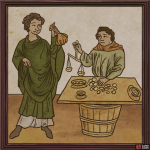Text
In the Middle Ages, money took the form of minted coins, with values corresponding to the amount of usable precious material (gold or silver).
In Bohemia, the long-standing silver Prague groschen was in use. However, in the Middle Ages, the decimal system was not used in everyday life, so one Prague groschen was divided into 7 pence, which were further divided into 14 heller. Similarly, counts were made in dozens (12) and threescores (‘kopa’- 60). Since this would be somewhat confusing for people today, the smallest unit in the game is 0.1 groschen.
The coins were circular in shape and were decorated on the reverse with the Bohemian lion in a square, while in Moravia they depicted an eagle.
Around the year 1400, the quality of the groschen noticeably declined (and thus its value), and more other metals began to be added to the silver. This was related to the excessive exploitation of the richest metal deposits around Kuttenberg and Jihlava (Iglau) in Moravia, and a shortage of goods for exchange with foreign countries.
The economic and financial problems at the time led to growing antisemitism, an increase in crime, and ultimately the collapse of the Bohemian currency. In addition to genuine coins, counterfeit coins (forgeries) were also in circulation. Counterfeiting was one of the most serious crimes and was punishable by burning at the stake.
Small silver coins were minted until the Hussite wars. On the obverse was a crown or the crowned head of the ruler. The quality was checked in the mint by two mint masters, who confirmed the metal content with an oath upon their lives. The prices of goods and items varied locally and were valid for only a very short time.


No Comments